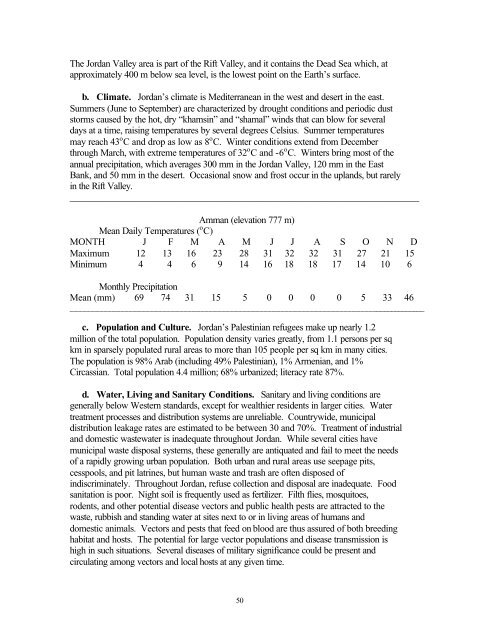Middle East DVEP - Armed Forces Pest Management Board
Middle East DVEP - Armed Forces Pest Management Board
Middle East DVEP - Armed Forces Pest Management Board
Create successful ePaper yourself
Turn your PDF publications into a flip-book with our unique Google optimized e-Paper software.
The Jordan Valley area is part of the Rift Valley, and it contains the Dead Sea which, atapproximately 400 m below sea level, is the lowest point on the Earth’s surface.b. Climate. Jordan’s climate is Mediterranean in the west and desert in the east.Summers (June to September) are characterized by drought conditions and periodic duststorms caused by the hot, dry “khamsin” and “shamal” winds that can blow for severaldays at a time, raising temperatures by several degrees Celsius. Summer temperaturesmay reach 43 o C and drop as low as 8 o C. Winter conditions extend from Decemberthrough March, with extreme temperatures of 32 o C and -6 o C. Winters bring most of theannual precipitation, which averages 300 mm in the Jordan Valley, 120 mm in the <strong>East</strong>Bank, and 50 mm in the desert. Occasional snow and frost occur in the uplands, but rarelyin the Rift Valley.________________________________________________________________________Amman (elevation 777 m)Mean Daily Temperatures ( o C)MONTH J F M A M J J A S O N DMaximum 12 13 16 23 28 31 32 32 31 27 21 15Minimum 4 4 6 9 14 16 18 18 17 14 10 6Monthly PrecipitationMean (mm) 69 74 31 15 5 0 0 0 0 5 33 46______________________________________________________________________________________c. Population and Culture. Jordan’s Palestinian refugees make up nearly 1.2million of the total population. Population density varies greatly, from 1.1 persons per sqkm in sparsely populated rural areas to more than 105 people per sq km in many cities.The population is 98% Arab (including 49% Palestinian), 1% Armenian, and 1%Circassian. Total population 4.4 million; 68% urbanized; literacy rate 87%.d. Water, Living and Sanitary Conditions. Sanitary and living conditions aregenerally below Western standards, except for wealthier residents in larger cities. Watertreatment processes and distribution systems are unreliable. Countrywide, municipaldistribution leakage rates are estimated to be between 30 and 70%. Treatment of industrialand domestic wastewater is inadequate throughout Jordan. While several cities havemunicipal waste disposal systems, these generally are antiquated and fail to meet the needsof a rapidly growing urban population. Both urban and rural areas use seepage pits,cesspools, and pit latrines, but human waste and trash are often disposed ofindiscriminately. Throughout Jordan, refuse collection and disposal are inadequate. Foodsanitation is poor. Night soil is frequently used as fertilizer. Filth flies, mosquitoes,rodents, and other potential disease vectors and public health pests are attracted to thewaste, rubbish and standing water at sites next to or in living areas of humans anddomestic animals. Vectors and pests that feed on blood are thus assured of both breedinghabitat and hosts. The potential for large vector populations and disease transmission ishigh in such situations. Several diseases of military significance could be present andcirculating among vectors and local hosts at any given time.50

















